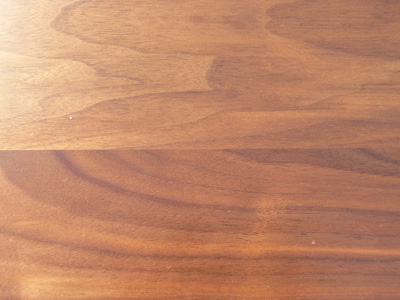The Tree: Juglandaceae family - The black walnut's specific name is Juglans Nigra. The black walnut is sometimes called Eastern or American black walnut found typically growing in a mixed hardwood forest, with light coverage. There are about twenty species of walnut with six found in the US. Black walnuts were once abundant in old growth forests with trees reaching 150 feet with six-foot diameter trunks. Today's trees are generally 80-100 feet tall with trunks of less than three feet. The black walnut has one interesting feature in that it can poison neighboring trees and shrubs with a substance called juglone found in the roots. This allows the tree to protect its territory and assuring its access to good sunlight necessary for its growth. It
Principal Uses: Walnut lumber is used for stair treads, flooring, gunstocks and other firearm grips and stocks, fine furniture, architectural woodwork, musical instruments, decorative panels, and interior trim. Large amounts are also used for veneer. Its stability and shock resistance make it the wood of choice for gun stocks. High end rifle stocks are more frequently made from other walnuts, such as Claro, that have similar physical properties but even greater beauty (and correspondingly higher cost). It is appreciated for its "easy of use" and beautiful colors to use as a craft wood for small turning and scrollsaw projects. The fact that it is the only dark North American wood, has added to its reputation.
Appearance: Walnut sapwood is creamy white and may be up to three inches wide. Heartwood is a rich chocolate or purplish brown in color, with a dull sheen. Black walnut is normally straight grained and is noted for its beautiful grain character, producing more figure variation than any other wood. Over the years the wood develops a lustrous patina. It is the only dark brown US domestic species, so it has a large following of devoted woodworkers, that enjoy its rich color and ease of use
Weight: approx. 36-38 lbs. per cubic foot
Machining: Walnut works easily with power or hand tools but may cause some dulling of cutting edges. Planing, turning, shaping, routing and sanding all produce crisp detail. With figured crotch wood it is necessary to watch the direction of feed, in both thickness planers and jointers. Fasteners hold well with little tendency to split. Standard adhesives and stains go on uniformly. Wood is rated tough and hard with good steam bending qualities and little movement in service. Wood and sawdust of black walnut are known to cause irritation of the eyes, nose, skin and lungs, and may stimulate allergies and asthma - precautionary measures are advised. The use of a dust mask is recommended.
Color Range: Light to dark brown or chocolate brown and can appear almost deep purple is some lighting conditions. Sapwood can be creamy tan to nearly white with some chocolate brown heartwood dispersed.
Other Interesting Information: Walnut takes any finish and most finishes complement the lovely satin sheen of the wood. It polishes well. Walnut is usually steamed to match sapwood and heartwood and has fine but open grain. It has a moderately coarse texture.










Log In